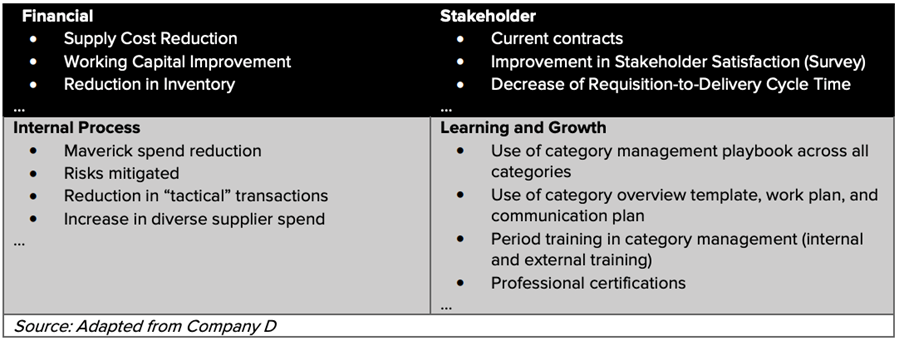With your category management strategy in place, it's time to monitor and measure the benefits it delivers to your organization and identify opportunities for improvement. To succeed long term, the category strategy must remain aligned with business objectives and the dynamics of the supplier marketplace. This requires regular re-evaluation.
Measure the benefits of following the category management playbook by tracking hard metrics (like spend, savings, and supplier performance) and soft benefits (like improved supplier relationships) that benefit all parties.
Measuring category management effectiveness is the final and ongoing step in the 7 stages to business-aligned strategies that organizations should follow as part of their category management playbook. This series of posts summarizes the valuable findings from a recent CAPS whitepaper, A Playbook for Category Management.
7 stages to-business aligned strategies
- Preparation
- Internal Analysis
- External Analysis
- Category Strategy Development
- Negotiation and Contracting
- Supplier Relationship Management
- Category Performance Management
Category management gives supply management professionals the tools to engage with cross-functional stakeholders and identify and understand internal needs, analyze the internal demand for goods and services, analyze the supply market and competitive environment, and engage with external stakeholders (e.g. suppliers) to improve each category.
Once an organization’s category management strategy is up and running, it takes ongoing oversight to assess the benefits and adjust when necessary. Ongoing category management evaluation involves:
- Monitoring supplier compliance with contractual terms and agreements
- Assessing supplier performance on key performance indicators
- Sharing performance information with suppliers
- Identifying opportunities for improvement
Procurement leaders report that category management is most effective for business-critical categories that receive the most management attention. In other less critical categories, the system may be less effective.
To assess performance relative to the organization’s goals and identify opportunities to improve, many procurement teams use a balanced scorecard that combines non-financial performance measures and traditional financial metrics.
Performance categories to track in a balanced scorecard
The CAPS whitepaper reveals that the following categories are important to track as part of a balanced scorecard, with a sample scorecard pictured below.
- Financial
- Customer/stakeholder
- Internal processes
- Learning & growth
- Balanced Scorecard Example

Drivers of category management effectiveness
Building on the balanced scorecard, five critical success factors drive category management effectiveness are:
- Alignment with business drivers
- Training of category team
- Close relationships with suppliers
- Top management support
- Organizational design
These elements are necessary to develop a mature program that contributes long-term value to the organization.
Robust category management can help organizations prepare for the adoption of technological solutions to automate routine spend. In that environment, professionals will focus more on strategic tasks that create value for the organization. By aligning requirements for goods and services with supply market capabilities, category management creates a foundation to adopt category-specific automation while focusing on innovation for critical categories.
Over time, the organization can track the maturity of the category management strategy to benchmark performance and identify gaps and areas of improvement. Organizations find that some categories are more mature than others, such as direct vs. indirect spend, or that maturity varies by geographic location.
Characteristics of mature category management
- Policies and playbooks for category management
- Accountability for results
- Continuous assessment across the organization
- Early engagement with suppliers
- Transfer excellence across business units
- Funnel all supplier commitments through procurement
- Apply other strategies, such as insourcing vs. outsourcing
- Continuous training
- Assessment approach that supports continuous development toward a mature category management organization
The category management playbook is a tool to help minimize the total cost of ownership, ensure supply continuity, and leverage relationships with suppliers to enhance innovation and reduce supply risk. Use the links above to read any of the 7 stages to enhance your category management strategy.
From the CAPS Research whitepaper, A Playbook for Category Management, CAPS Research, November 2020.
Members get priority access
Explore the entire CAPS Library
Reports released within the last seven years are reserved for members, but anyone may create a free account in the CAPS Library and access more than 30 years of KPIs, best practices, and thought leadership. Employees of CAPS member companies can access the full report in the CAPS Library now.
Members: download this report Learn more about CAPS membership
Non-members can receive the report of each survey they submit.
Members can access all reports, but are encouraged to submit surveys to
increase the comparative breakouts only they receive.